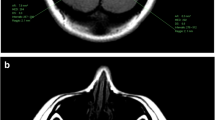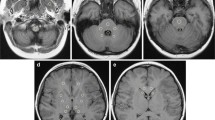Abstract
Objectives
To evaluate the impact of previous administration of gadodiamide and neural tissue gadolinium deposition in patients who received gadobenate dimeglumine.
Methods
Our population included 62 patients who underwent at least three administrations of gadobenate dimeglumine, plus an additional contrast-enhanced last MRI for reference, divided into two groups: group 1, patients who in addition to gadobenate dimeglumine administrations had prior exposure to multiple doses of gadodiamide; group 2, patients without previous exposure to other gadolinium-based contrast agent (GBCAs). Quantitative analysis was performed on the first and last gadobenate dimeglumine MRIs in both groups. Dentate nucleus-to-middle cerebellar peduncle signal intensity ratios (DN/MCP) and relative change (RC) in signal over time were calculated and compared between groups using generalized additive model.
Results
Group 1 showed significant increase in baseline and follow-up DN/MCP compared to group 2 (p < 0.0001). The RC DN/MCP showed a non-statistically significant trend towards an increase in patients who underwent previous gadodiamide (p = 0.0735).
Conclusion
There is increased T1 signal change over time in patients who underwent gadobenate dimeglumine and had received prior gadodiamide compared to those without known exposure to previous gadodiamide. A potentiating effect from prior gadodiamide on subsequent administered gadobenate dimeglumine may occur.
Key Points
• Neural gadolinium deposition is associated with multiple administrations of less stable GBCAs.
• Less stable GBCA effect on subsequent more stable GBCA administrations is undetermined.
• Significant increase of DN/MCP was seen in patients with previous gadodiamide exposure.
• RC DN/MCP showed a non-significant increase in patients who received previous gadodiamide.
• Potentiating effects from prior gadodiamide on subsequent administered gadobenate dimeglumine may occur.





Similar content being viewed by others
Abbreviations
- DN:
-
dentate nucleus
- GBCA:
-
gadolinium-based contrast agent
- MCP:
-
middle cerebellar peduncle
- RC:
-
relative change
- SI:
-
signal intensity
References
Kanda T, Ishii K, Kawaguchi H, Kitajima K, Takenaka D (2014) High signal intensity in the dentate nucleus and globus pallidus on unenhanced T1-weighted MR images: relationship with increasing cumulative dose of a gadolinium-based contrast material. Radiology 270(3):834–841
Errante Y, Cirimele V, Mallio CA, Di Lazzaro V, Zobel BB, Quattrocchi CC (2014) Progressive increase of T1 signal intensity of the dentate nucleus on unenhanced magnetic resonance images is associated with cumulative doses of intravenously administered gadodiamide in patients with normal renal function, suggesting dechelation. Invest Radiol 49(10):685–690
Quattrocchi CC, Mallio CA, Errante Y et al (2015) Gadodiamide and dentate nucleus T1 hyperintensity in patients with meningioma evaluated by multiple follow-up contrast-enhanced magnetic resonance examinations with no systemic interval therapy. Invest Radiol 50(7):470–472
Ramalho J, Castillo M, AlObaidy M et al (2015) High signal intensity in globus pallidus and dentate nucleus on unenhanced T1-weighted MR images: evaluation of two linear gadolinium-based contrast agents. Radiology 276(3):836–844
Kanda T, Osawa M, Oba H et al (2015) High signal intensity in dentate nucleus on unenhanced T1-weighted MR images: association with linear versus macrocyclic gadolinium chelate administration. Radiology 275(3):803–809
Radbruch A, Weberling LD, Kieslich PJ et al (2015) Gadolinium retention in the dentate nucleus and globus pallidus is dependent on the class of contrast agent. Radiology 275(3):783–791
Cao Y, Huang DQ, Shih G, Prince MR (2016) Signal change in the dentate nucleus on T1-weighted MR images after multiple administrations of gadopentetate dimeglumine versus gadobutrol. Am J Roentgenol 206(2):414–419
McDonald RJ, McDonald JS, Kallmes DF et al (2015) Intracranial gadolinium deposition after contrast-enhanced MR imaging. Radiology 275(3):772–782
Kanda T, Fukusato T, Matsuda M et al (2015) Gadolinium-based contrast agent accumulates in the brain even in subjects without severe renal dysfunction: evaluation of autopsy brain specimens with inductively coupled plasma mass spectroscopy. Radiology 276(1):228–232
Robert P, Lehericy S, Grand S et al (2015) T1-weighted hypersignal in the deep cerebellar nuclei after repeated administrations of gadolinium-based contrast agents in healthy rats: difference between linear and macrocyclic agents. Invest Radiol 50(8):473–480
Robert P, Violas X, Grand S et al (2016) Linear gadolinium-based contrast agents are associated with brain gadolinium retention in healthy rats. Invest Radiol 51(2):73–82
Radbruch A, Weberling LD, Kieslich PJ et al (2015) High-signal intensity in the dentate nucleus and globus pallidus on unenhanced T1-weighted images. Invest Radiol 50(12):805–810
Weberling LD, Kieslich PJ, Kickingereder P et al (2015) Increased signal intensity in the dentate nucleus on unenhanced T1-weighted images after gadobenate dimeglumine administration. Invest Radiol 50(11):743–748
Frenzel T, Lengsfeld P, Schirmer H, Hütter J (2008) Stability of gadolinium-based magnetic resonance imaging contrast agents in human serum at 37 degrees C. Invest Radiol 43(12):817–828
Kasahara S, Miki Y, Kanagaki M et al (2011) Hyperintense dentate nucleus on unenhanced T1-weighted MR images is associated with a history of brain irradiation. Radiology 258(1):222–228
Roccatagliata L, Vuolo L, Bonzano L, Pichiecchio A, Mancardi GL (2009) Multiple sclerosis: hyperintense dentate nucleus on unenhanced T1-weighted MR images is associated with the secondary progressive subtype 1. Radiology 251(2):503–510
Core Team R (2015) R: a language and environment for statistical computing. R Foundation for Statistical Computing, Vienna, Austria
Hastie TJ, Tibshirani RJ (1990) Generalized additive models, 1st edn. Chapman & Hall/CRC, London
Lin LI (1989) A concordance correlation coefficient to evaluate reproducibility. Biometrics 45(1):255–268
Oksendal AN, Hals PA (1993) Biodistribution and toxicity of MR imaging contrast media. J Magn Reson Imaging 1;3(1):157–165
Idée J-M, Port M, Raynal I, Schaefer M, Le Greneur S, Corot C (2006) Clinical and biological consequences of transmetallation induced by contrast agents for magnetic resonance imaging: a review. Fundam Clin Pharmacol 20(6):563–576
Acknowledgments
The scientific guarantor of this publication is Richard C. Semelka. The authors of this manuscript declare no relationships with any companies whose products or services may be related to the subject matter of the article. The authors state that this work has not received any funding. One of the authors has significant statistical expertise. Institutional review board approval was obtained. Written informed consent was waived by the institutional review board. No study subjects or cohorts have been previously reported. Methodology: retrospective, case-control study, performed at one institution.
Author information
Authors and Affiliations
Corresponding author
Rights and permissions
About this article
Cite this article
Ramalho, J., Semelka, R.C., AlObaidy, M. et al. Signal intensity change on unenhanced T1-weighted images in dentate nucleus following gadobenate dimeglumine in patients with and without previous multiple administrations of gadodiamide. Eur Radiol 26, 4080–4088 (2016). https://doi.org/10.1007/s00330-016-4269-7
Received:
Revised:
Accepted:
Published:
Issue Date:
DOI: https://doi.org/10.1007/s00330-016-4269-7




